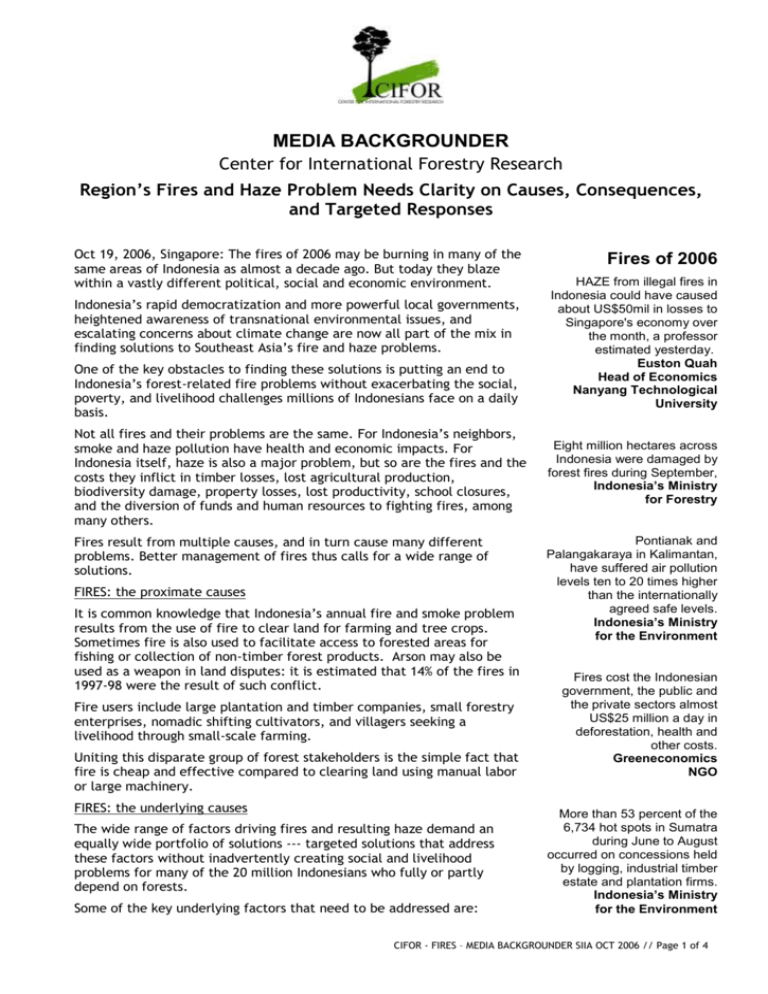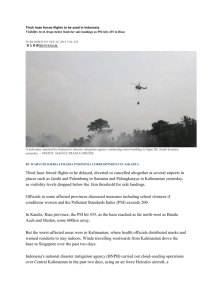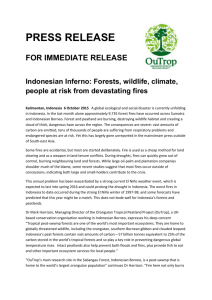MEDIA BACKGROUNDER
advertisement

MEDIA BACKGROUNDER Center for International Forestry Research Region’s Fires and Haze Problem Needs Clarity on Causes, Consequences, and Targeted Responses Oct 19, 2006, Singapore: The fires of 2006 may be burning in many of the same areas of Indonesia as almost a decade ago. But today they blaze within a vastly different political, social and economic environment. Indonesia’s rapid democratization and more powerful local governments, heightened awareness of transnational environmental issues, and escalating concerns about climate change are now all part of the mix in finding solutions to Southeast Asia’s fire and haze problems. One of the key obstacles to finding these solutions is putting an end to Indonesia’s forest-related fire problems without exacerbating the social, poverty, and livelihood challenges millions of Indonesians face on a daily basis. Not all fires and their problems are the same. For Indonesia’s neighbors, smoke and haze pollution have health and economic impacts. For Indonesia itself, haze is also a major problem, but so are the fires and the costs they inflict in timber losses, lost agricultural production, biodiversity damage, property losses, lost productivity, school closures, and the diversion of funds and human resources to fighting fires, among many others. Fires result from multiple causes, and in turn cause many different problems. Better management of fires thus calls for a wide range of solutions. FIRES: the proximate causes It is common knowledge that Indonesia’s annual fire and smoke problem results from the use of fire to clear land for farming and tree crops. Sometimes fire is also used to facilitate access to forested areas for fishing or collection of non-timber forest products. Arson may also be used as a weapon in land disputes: it is estimated that 14% of the fires in 1997-98 were the result of such conflict. Fire users include large plantation and timber companies, small forestry enterprises, nomadic shifting cultivators, and villagers seeking a livelihood through small-scale farming. Uniting this disparate group of forest stakeholders is the simple fact that fire is cheap and effective compared to clearing land using manual labor or large machinery. FIRES: the underlying causes The wide range of factors driving fires and resulting haze demand an equally wide portfolio of solutions --- targeted solutions that address these factors without inadvertently creating social and livelihood problems for many of the 20 million Indonesians who fully or partly depend on forests. Some of the key underlying factors that need to be addressed are: Fires of 2006 HAZE from illegal fires in Indonesia could have caused about US$50mil in losses to Singapore's economy over the month, a professor estimated yesterday. Euston Quah Head of Economics Nanyang Technological University Eight million hectares across Indonesia were damaged by forest fires during September, Indonesia’s Ministry for Forestry Pontianak and Palangakaraya in Kalimantan, have suffered air pollution levels ten to 20 times higher than the internationally agreed safe levels. Indonesia’s Ministry for the Environment Fires cost the Indonesian government, the public and the private sectors almost US$25 million a day in deforestation, health and other costs. Greeneconomics NGO More than 53 percent of the 6,734 hot spots in Sumatra during June to August occurred on concessions held by logging, industrial timber estate and plantation firms. Indonesia’s Ministry for the Environment CIFOR - FIRES – MEDIA BACKGROUNDER SIIA OCT 2006 // Page 1 of 4 • Large areas of forest land have been allocated for conversion to other uses, but without suitable commensurate support for environmentally sound land-clearing practices. • Law enforcement efforts have been compromised by confusion over which government agencies are responsible for fire-related crimes, and incentives for compliance undermined by weak follow-up by the judicial system. • Forests are an important source of livelihoods for the rural poor, and fire is an important tool in pursuing those livelihoods. Forest-depended communities often face insecure tenure over land and resources. Fire solutions must also provide tenure and livelihood solutions in order to be both effective and just. • Decentralization of government authority means there are many more stakeholders involved in forestry decision-making process than was the case in the 1990s, rendering obsolete top-down implementation of national-level forest polices. • As more easily accessible upland forests disappear, peatland areas are increasingly harvested by companies and individuals. The shift to peatland areas exacerbates the haze problem. Indonesia’s 1997 peatland fires constituted some 60% of the region’s haze from only 20% of total area burnt. • Fire management efforts have focused on suppression rather than prevention, diverting large sums of money to often ineffective fire-fighting technologies at the expense of attention to underlying causes. FIRES: the possible solutions Peatland initiatives: • Rather than banning all fires outright, target burning bans to times, areas, and activities that pose a significant haze effect, such as fires used to clear peatlands. Use total fire bans only during El Nino years. • Prohibit large-scale developments that deforest or drain peatlands, or that otherwise improve access into interior areas. • Develop an El Nino response program for peatlands to reduce fire use and offer alternative livelihood options during El Nino events, preferably outside peatland areas. • Negotiate with communities and offer incentives for them to control burning and restore wetlands. Consider transfer payment programs to compensate forest-dependent communities for peat forest conservation utilizing financial mechanisms in international environmental agreements such as the climate convention. Legal/policy initiatives: • Improve land tenure systems to encourage communities to protect their forests and implement sustainable land management. Clarify property rights to reduce the kinds of conflict between small landholders and commercial interests that can lead to the use of arson. • Reconsider policies that designate forests areas for conversation to large-scale activities such as palm and pulp fiber plantations. Once forest land is reallocated to another use, fire becomes a standard tool in the land’s management. • Strengthen law enforcement mechanisms targeted at corporate misuse of fire, and follow through on punitive measures to make companies change their fire management practices. In 2005, 15 companies were charged with illegally causing fires, but the Environment Ministry says none of the cases have been settled. Indonesia’s peatlands: What the experts say SE Asia has 60% of the world’s tropical peatlands. Fire and ecological change in these areas could seriously exacerbate regional haze and global greenhouse gas emissions. Daniel Murdiyarso CIFOR If degraded peat lands are not rehabilitated and appropriate measures not enforced to protect intact ones, it is unlikely the 2002 ASEAN Agreement will benefit the region Luca Taconni CIFOR Indonesia’s peat swamps contain 21% of Earths landbased carbon. Unless actions are taken, that carbon could become hot-house gas in 40 years. Una Chokalingham CIFOR Peatlands should be recognized as critically important to negotiations on carbon sinks under the Kyoto Protocol, particularly in agricultural and forested landscapes. International Mire Conservation Group • Clearly articulate departmental responsibilities at all governmental levels for fire management, prevention, and law enforcement. CIFOR - FIRES – MEDIA BACKGROUNDER SIIA OCT 2006 // Page 2 of 4 • Strengthen the capacity of local governments to facilitate inclusive local decision-making on land allocation, and provide fiscal incentives to implement fire control measures. Technical initiatives • Support research on zero or reduced burning technologies for use by communities and plantation managers in areas vulnerable to escaped fires. For example, investigate harvesting practices to reduce logging residue and eliminate the need to burn an area before planting oil palm or timber-crop seedlings. • Support research on how vulnerable ecosystems and human communities in fire-prone areas can adapt. For example, research suggests that allowing salvage logging after forest fires and significantly compromise the ability of forests to recover. • Improve the skills of forest workers, communities, land managers in fire management. Policy interventions are needed, but given the variety of fires, each type requires a specific intervention. Daniel Murdiyarso CIFOR Information about Indonesia’s fires of 2006 October 19, 2006: While the data for this year’s fires is still being analyzed, the enormity of the fire problem is evidenced in the information below. This information has been compiled from publicly available sources deemed reliable by CIFOR, but CIFOR has not independently verified specific content. Size, extent and cost of fires: • In July Indonesia’s Forestry Ministry reported over 4,000 hotspots in Indonesia, mainly in Riau, Jambi, South Sumatra and across Kalimantan. Between Sept 27 and Oct 9, up to 500 fires a day occurred in West Kalimantan. According to media stories in July/August, 6,800 hectares in Riau and 10,000 hectares in Jambi were burnt. (UN Office for the Coordination of Humanitarian Affairs) • According to Indonesia’s Forestry Minister, MS Kaban, central Kalimantan has been the worst hit, with around 1 million hectares of peatland in one area on fire. (Reuters Oct 13) • In Java, 8,000 hectares have been destroyed, compared to 782 last year. This included 3,000 hectares of concession areas belonging to state-owned forestry company Perhutani. (Jakarta Post Oct 14) • South Sumatera Governor Syahrial Oesman says 55,815 hectares of land had been affected by fires and caused Rp 129.7 billion (US$14 million), with 16% of the fires on peat land. (Jakarta Post Oct 16) • Fires cost the government, the public and the private sectors Rp. 227 billion (almost US$25 million) a day in deforestation, health and other costs, according to Greeneconomics. (Jakarta Post Oct 14) Air pollution and health figures: • Indonesia’s Environment Minister, Rachmat Witoelar, said air pollution is the worst since 1997. Air particulate matter (ppm) was well above the official "very alarming” level of 300. Between Oct 1 – 3 the figure for Palangkaraya in Kalimantan ranged from 625 to 1,012 ppm. (Jakarta Post Oct 11; State Ministry of Environment) • Witoelar said his Department is yet to tally the data but says haze has caused respiratory problems, closed schools, disrupted airports and disturbed rare animals in protected forests. (Jakarta Post Oct 11) • On 5 Oct the WHO tightened its air pollution guidelines. It says air pollution causes over two million premature deaths a year. Over 50% in developing countries. On Oct 8 Singapore reported a pollution level of 150, its highest in nine years. (sci.dev.com) Peatland figures: July 2006, 56% of Riau’s fire hotspots and 30% West Kalimantan’s were on peatlands according to data from “Eyes on the Forest”, an NGO coalition consisting of WWF Tesso Nilo, Forest Rescue Network Riau and Walhi Riau, Friends of the Earth Indonesia. CIFOR - FIRES – MEDIA BACKGROUNDER SIIA OCT 2006 // Page 3 of 4 Land ownership and fire figures: NGO Eyes on the Forest says hotspots in Riau Province in July 2006 reached 1,419. Of that number: • 786 hotspots (55.39%) were situated inside community areas • 338 hotspots (23.82%) inside industrial timber plantation concessions • 295 hotspots (20.79%) inside palm oil plantations In the period of July 1–25 in West Kalimantan, there were 684 hotspots detected, with: • 400 (58.48%) situated inside community areas • 66 (24.27%) inside concession of palm oil plantations • 60 (8.77 %) inside industrial timber plantation concessions • 58 (8.48%) inside selective logging concessions. (www.wwf.biz/news_facts/newsroom/news/) Groups blamed for 2006 fires • Walhi reported 176 plantation companies to the police for allegedly burring forest to convert them into plantations. (Jakarta Post Oct 14) • The Government has identified seven companies to be investigated for starting fires. (UNOCHA Aug 25) • Forestry Minister MS Kaban said [his] Ministry [was among] the victims, with 75% of fires not in government forests but on plantations and farms belonging to private companies and local people. (Reuters Oct 13 and Media Indonesia Oct 12) • The South Sumatra Forestry Office is reported as saying “as usual, the local people burn the land without stopping.” (Kompas Oct 13) • The Governor for Garut Regency said the forest fires in Garut were due to carelessness by local farmers. (Pikiran Rakyat Oct 13) Recent Comment • Central Kalimantan Governor Agustin Teras Narang said the government needed to enact a stricter law and push for united action by local people to deal with the fires. "A government regulation in lieu of law should be issued to enable us to take action.” (Jakarta Post Oct 16) • Walhi executive director Chalid Muhammad called for stricter regulation authorizing the government to revoke the licenses of businesses and punish individuals who cause fires. (Jakarta Post Oct 16) • “Violations by plantation companies are still happening in the form of illegal land clearance,'' Yudhoyono said. “This is clearly a crime.'' (Bloomberg Oct 11) ENSO (El Nino Southern Oscillation) ENSO will likely create drier-than-average weather during November to March [2006-07] over most of Malaysia and Indonesia, according to the Climate Prediction Center, an agency of the National Oceanic Atmospheric Administration. (USA Today Oct 10) For further information or an interview with CIFOR’s Director General Ms Frances Seymour Contact: Greg Clough +62 8128646613 +62 251 322734 +62 251 622622 g.clough@cgiar.org Ms Frances Seymour +62 8121115371 +62 251 622071 f.seymour@cgiar.org ---Headquartered in Indonesia, the Center for International Forestry Research (CIFOR) (http://www.cifor. cgiar.org) is a leading international forestry research organization established in response to global concerns about the social, environmental, and economic consequences of forest loss and degradation. CIFOR is dedicated to developing policies and technologies for sustainable use and management of forest goods and services, and for enhancing the well being of people in developing countries who rely on tropical forests. CIFOR is one 15 food and environmental research centers that are primarily funded through the Consultative Group on International Agricultural Research (http://www.cgiar.org). CIFOR - FIRES – MEDIA BACKGROUNDER SIIA OCT 2006 // Page 4 of 4





